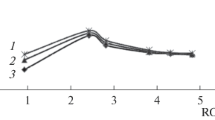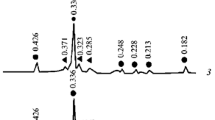The process of forming, by means of a proposed technology, the transitional layer between a dispersed medium and a dispersed phase of a ceramic matrix composite is investigated and a method of fabricating multilayer samples modeling at the macro level the interface between phases in the direction matrix–core of the composite material is presented. A qualitative and semiquantitative analysis is presented of new phases which are products of an interaction, occuring during firing, of a core made from sludgy iron-ore wastes and a matrix made from clayey raw material.






Similar content being viewed by others
References
B. V. Talpa and V. D. Kotlyar, “Mineral and raw material base of lithified clay rocks of the South Russia for the production of building ceramics,” Stroit. Mater., No. 4, 31 – 33 (2015).
N. F. Solodkii, A. S. Shamrikov, and V. M. Pogrebenkov, Urals Mineral Resources Base for the Ceramic, Refractory and Glass Industry: Handbook [in Russian], Izd. TPU, Tomsk (2009).
A. M. Salakhov, R. R. Kabirov, and G. R. Faseeva, “Use of industrial waste from a petrochemical complex in the technology of building ceramics,” Vest. Kazanskogo Tekhnol. Univer., 18(14), 81 – 83 (2015).
V. A. Guryeva, “Magnesia technogenic raw materials in the production of building ceramic materials,” Vest. Yuzhno-Uralsk. Gos. Univer., Ser. Stroit-vo Arkhitektura, 13(1), 45 – 48 (2013).
V. Z. Abdrakhimov, G. R. Khasaev, E. S. Abdrakhimova, et al., “Ecological, theoretical and practical aspects of using aluminum-containing waste in the production of ceramic materials for various purposes without the use of conventional native raw materials,” Ekol. Prom-st’ Rossii, No. 5, 28 – 32 (2013).
A. E. Buruchenko, “Possibilities of using secondary raw materials for building ceramics and glass ceramics,” Vest. Tuvin. Gos. Univer., Tekhn. Fiz.-Mat. Nauki, No. 3(18), 7 – 14 (2013).
R. Z. Rakhimov, U. Kh. Magdeev, and V. N. Yarmakovskii, “Ecology, scientific achievements and innovations in the production of building materials based on and using technogenic raw materials,” Stroit. Mater., No. 12, 8 – 11 (2009).
E. M. Aksenov, N. G. Vasil’ev, and P. P. Senatorov, “Status, problems of development, and development prospects for a raw material base for non-metallic minerals,” Mineralnye Resursy Rossii, Ékonomika i Upravlenie, No. 4, 49 – 59 (2017).
T. N. Ledashcheva and V. Ye. Pinayev, “Waste management in the plan for environmental protection measures,” Otkhody Resursy, 3(3), 3 – 11 (2016).
A. Yu. Stolboushkin, G. I. Berdov, V. I. Vereshchagin, and O. A. Fomina, “Ceramic wall materials with matrix structure based on non-caking, non-plastic man-made, and native raw materials,” Stroit. Mater., No. 8, 19 – 23 (2016).
R. Christensen, Introduction to the Mechanics of Composites, Mir, Moscow (1982).
V. D. Kotlyar, “Siliceous opoka rocks of Krasnodarskii krai—a promising raw material for wall ceramics,” Stroit. Mater., No. 4, 34 – 36 (2010).
V. I. Vereshchagin, V. M. Pogrebenkov, and T. V. Vakalova, “Use of native and technogenic raw materials of the Siberian region in the production of building ceramics and heat-insulating materials,” Stroit. Mater., No. 7, 28 – 31 (2004).
B. K. Kara-sal, S. A. Chyudyuk, and T. V. Sapelkina, “Evaluation of chemical and mineralogical compositions of overburden of Tuva coal mining as a raw material for the production of ceramic wall materials,” Estestv. Tekhnich. Nauki, No. 12(114), 336 – 339 (2017).
T. V, Vakalova, V. M. Pogrebenkov, and I. B. Revva, “Prospects for expanding the domestic raw material base of building ceramics through the integrated use of clay deposits,” Vest. Nauki Sibiri, No. 1(2), 339 – 347 (2012).
A. Yu. Stolboushkin, “Promising direction for the development of building ceramic materials from low-quality raw materials,” Stroit. Mater., No. 4, 24 – 28 (2015).
A. Stolboushkin, V. Syromyasov, V. Vereschagin, and O. Fomina, “Macromodel of interfacial transition layer in ceramic matrix composites,” in: MATEC Web of Conferences: IV International Young Researchers Conference “Youth, Science, Solutions: Ideas and Prospects” (YSSIP-2017), Tomsk, Russia, October 25 – 27, 2017, Vol. 143, 02003 (2018), pp. 1 – 7, https://doi.org/10.1051/matecconf/201714302003.
V. S. Gorshkov, V. G. Saveliev, and A. V. Abakumov, Binding, Ceramics, Glass and Glass-Crystalline Minerals [in Russian], Stroiizdat, Moscow (1995).
A. Yu. Stolboushkin and G. I. Storozhenko, “Necessity and prospects of recycling Kuzbass sludge iron ore wastes in the technology of wall ceramic materials,” Stroit. Mater., No. 4, 77 – 84 (2009).
A. Yu. Stolboushkin and O. A. Fomina, “Research and forecasting of solid-phase reactions during the firing of ceramic matrix composites,” Izv. Vyssh. Uchebn. Zaved., Stroit-vo, No. 7, 23 – 35 (2016).
The results of these studies were obtained as part of the fulfillment of the state task of the Ministry of Education and Science of the Russian Federation (project No. 7.7285.2017/8.9) ‘Basic research in the field of construction ceramic composite materials with matrix structure based on technogenic and native raw materials.’
Author information
Authors and Affiliations
Corresponding author
Additional information
Translated from Steklo i Keramika, No. 1, pp. 19 – 25, January, 2019.
Rights and permissions
About this article
Cite this article
Stolboushkin, A.Y., Vereshchagin, V.I. & Fomina, O.A. Phase Composition of the Core–Shell Transition Layer in a Construction Ceramic Matrix Structure Made from Non-Plastic Raw Material with Clay Additives. Glass Ceram 76, 16–21 (2019). https://doi.org/10.1007/s10717-019-00124-3
Published:
Issue Date:
DOI: https://doi.org/10.1007/s10717-019-00124-3




